Monte Cook's Arcana Evolved by Monte Cook by Valatar
Part 1
Original SA post
(A lesson in why word of mouth is insufficient advertising.)

Before Pathfinder, before 3.5, Malhavoc Press put out a variant D20 system by Monte Cook, one of the D&D designers who'd left WotC some years before. It was called Arcana Unearthed, which served primarily to confuse the hell out of people who kept mistaking it for Unearthed Arcana. The homage was cute enough, as like Unearthed Arcana, Arcana Unearthed put forth more interesting classes and races and some rule mechanics, but I believe the confusion engendered by the name didn't do the book any favors. A couple of years later, Malhavoc re-released the book with expanded content and colored art, renaming it Arcana Evolved. 3.5 was out by this point and the gaming market was oversaturated with D20 content, so despite the fact that the name was less confusing, it still never gained much traction. Unfortunately for Arcana Evolved, Monte has a raging case of ADD and can't stick with any project for any length of time; AE languished with virtually no support from the day it was printed. By the time fourth edition came out and the world was clamoring for better 3E content, Arcana Evolved was well off most peoples' radars as an abandoned product, permitting Pathfinder to stroll in and scoop up the 3.75 crown without any competition.

Where Pathfinder made 3.75 by revamping the generic D&D classes, AE made 3.75 by throwing out the D&D classes and making new, better classes. Depending on one's attachment to the traditional D&D setup, this can be a pro or a con. AE's classes are fundamentally different and making them work with D&D settings and content is often much like getting a square peg in a round hole. Anyone attached to premade D&D adventures will probably not be able to get much from Arcana Evolved. But anybody who is willing to throw out D&D's trappings completely and work with a clean slate will find a lot to work with in AE. Races, classes, feats, and magic have all been cleaned up from their original iterations. Most stupid blunders have been fixed, poor options have been buffed, and generally speaking everything makes more sense. Additionally, several of the improvements over 3E in Arcana Evolved are implemented in 5th edition, including the more flexible spell use and combat things for melee fighters to do aside from basic attacks.
Race Upgrades
In a manner not unlike the Savage Species splatbook, AU introduced the concept of racial levels for its races. However, where Savage Species had racial levels to essentially let a player "buy" a powerful monster species over time by leveling up as the monster before being able to take character levels, the racial levels in AE are wholly optional for a player to take. Whether a racial level is a better choice than a class level hinges heavily on your character concept; racial levels include some very useful stuff like breath weapons, spell-like abilities, flight, and size upgrades, but they delay class progression and can lead to painful sacrifices, especially for spellcasters. AE goes a step beyond AU in having "evolved levels", which are levels above and beyond the base racial levels with even more benefits, but which require one to be beholden to dragons to acquire.
Class Upgrades
The eternal spellcaster/non-caster divide exists in AE. However, AE also contains several steps taken to turbocharge the non-casters and reduces the gulf between them and casters considerably. Many classes are hybrids that have some measure of available spells to go with face-stabbing, or other supernatural abilities to liven things up past "I attack with my axe." The pure-melee classes have access to abilities called combat rituals, which are free actions that give short term buffs to the user for various combat activities. In addition, everything in AE is writ large: none of the classes are subdued wallflowers and each one possesses at least one ability that lets them be a complete badass at what they do.
Feat Upgrades
I'm just going to paste the text from Sturdy, the feat that replaces Toughness, which provides a whopping +3 HP:
quote:
For the level when the character takes this feat, she
adds double her Constitution bonus to her hit point total. This
is in addition to the bonus she would get for her Constitution
modifier when she gains a level. If double her Constitution
bonus is less than 4, she gains 4 hp. This effect happens once,
not every level.
For example, if a 3rd-level warmain with 22 hit points and a
+3 Constitution bonus takes this feat, she gains 6 additional hit
points in addition to the 1d12+3 she normally would gain for the
level. So, if she rolled a 7, her new total would be 38 hp (22 + 7
+ 3 + 6).
Magic Upgrades
AE's magic system is akin to D&D sorcerers in that like sorcerers you have spell slots instead of only having a specific number of spells to cast in a day, but like wizards you can swap around which spells you have memorized. The number of spells you can have memorized at a time rises with level, and you can swap out which spells are memorized with an hour of downtime, which is fine if you need to sit down for an hour to memorize Spell Resistance before going into the insane cult leader's tower, not so fine if you forgot to memorize Open Lock and the angry dragon is coming around the corner in ten seconds.
AE then goes on to leave D&D squarely in the dust by letting you swap lower-level spell slots for higher-level ones at a 3:1 exchange rate, or swap higher-level spell slots for lower-level ones at a 1:2 exchange rate. (You can't use these exchanged spell slots to then exchange to a yet-higher or lower tier. If you blow a 5th level slot for two 4th, you can't then use those to get four 3rd or things would get out of hand fast.) You can also choose to cast a spell at one lower level for a diminished effect, or at one higher level for a heightened effect. In many cases the diminished/heightened effect is obvious, in a few it makes the spell perform completely differently. There are additionally magical templates that can be applied to spells, you acquire them through feats or class features and they behave like metamagic, modifying the spell in exchange for adding a downside such as an expensive material component, taking longer to cast, etc. The end result is that spellcasters have more to do than ever before.
Anti-Magic Upgrades
No few people believe that magic doesn't need any upgrading whatsoever, and AE's casters are undeniably dangerous with the amount of flexibility they possess. So here are some steps taken to make sure that casters can't just faceroll their way through everything.
This is not 4th edition, and it really can’t be honestly claimed that pure melee fighters are going to keep up with the raw damage output of high-level casters when said casters are dropping ten fireballs in a day given that most gaming groups only go through on average three or so fights before stopping for a game-day. However, the pure melee people are going to be putting out consistently more damage and have more tricks up their sleeves than at any time in 3rd edition, and have defensive upgrades as well to put them in a better position to deal with a deadlier battlefield. I wouldn’t go so far as to call the casters squishy, as no class has a hit die under d6 in AU, but they’re also lacking a lot of the defensive spells that casters took for granted in D&D, so a big brawl is relatively riskier for the guy standing around without armor.
-
The concentration check to avoid AoOs is the big angry guy with the big sword's attack bonus + spell level instead of 15 + spell level, making it much more difficult to cast if someone's in your face.
-
Many casters are reliant on having access to magic tools to cast; if you disarm them and take their staff, pickpocket away their voodoo bag, sunder their magic sword, etc, they are gimped until they get it back.
-
Spells are now categorized as simple, complex, or exotic, and most spellcasting classes only get access to simple spells by default. Feats or special class abilities are necessary to get the better spells, and the most dangerous spells are walled away in the exotic spell class. While that doesn't make them unattainable by any measure, it does mean that they have to be paid for.
-
Save-or-die spells are gone. Save-or-be-screwed-and-coup-de-graced spells are not, however, so DMs may wish to keep an eye on those.
-
Spells in general are weaker than D&D standard. Casters still have decent access to raw damage, but the really exploitable stuff like Polymorph and the Summon Monster line are gone.
- Magic healing is less abundant than in D&D and often carries a cost, either from emergency heals leaving scars on the injured person from the sloppy rush job, or more careful healing transferring the pain to the caster in the form of subdual damage in exchange for doing the healing.
Melee Upgrades
So you just want to avoid the whole magic thing entirely. You almost have to go out of your way to do so in AE; between the races with spell-like abilities, the feats that grant mystical powers, and all of the classes with a dabble of spells or other supernatural boosts, being the guy who just smashes someone else's face in requires a deliberate choice on the player's end. However, for those players, AE has you covered. Weapons and armor have been upgraded with a larger selection of exotic weapons, the introduction of exotic armor, the removal of some annoying weapon restrictions (weapon finesse now works on any weapon considered light for your size instead of a specific list, sneak attacks can be performed with any weapon, etc.) and the addition of a parry stat on several weapons that provide an AC bonus to the wielder. No longer are the weapon and armor lists comprised of 5% obvious optimal choices and 95% chaff; weapons and armor are better balanced than in core D&D. There are unfortunately still some fairly stupid impractical weapons (such as the swordaxe, which is as awful as it sounds) though nothing on the facepalm scale as high as the urgrosh, dire flail or the gnomish suicide pick.
Melee feats have been expanded upon over core D&D by a great deal, allowing for combat maneuvers like 'use your attack of opportunity to stab that guy your friend just stabbed' and 'nail the bugbear right in the nads to daze it for a round' and 'dual wield longswords'. The basic combat feats like expertise and power attack are still present, still mathematically relevant, and still mostly boring.
And as I mentioned up in the class upgrades section, AE introduces a feature called combat rites that expands greatly on melee combat. They're akin to spells in that you have a set number of times you can use them per day, but they don't require casting or materials, provoke AofOs, etc; they're free actions and the only restrictions are that you can only use one per round and you can't use them flat-footed. They significantly up the variety of what a character can do, giving bonuses such as boosted move speed, increased charge damage, deflecting arrows, instant self-healing, taking an attack meant for the guy next to you, and a fair bit more. Only one non-magical melee class does not get free access to these abilities, and anybody can get them by taking feats to buy access.
Quality of Life Upgrade
There is a much larger buffer past 0 hit points before keeling over for characters with higher consitution in AE. Instead of disabled at 0 and dead at -10, characters are disabled at 0-their con bonus, then dying all the way until they exceed their consitution score. So a tough guy with 16 constition is still able to act at -3 HP and won't die until hitting -17. Healing magic is also available to any and all spellcasters who choose to learn the spells, so nobody is stuck with being the dedicated walking bandage dispenser. Someone really eager to be a healer will get some added perks by being a greenbond or a wood witch, but any caster can do a good job of keeping a party on their feet.
Monster Upgrades
AE has taken some steps to cut down on the 'hordes of faceless cannon fodder' syndrome that exists in a lot of fantasy roleplaying. First, undead are a Big Deal: mindless undead like your random skeleton and zombie horde don't exist. Any undead you find are generally intelligent, have unique abilities, and are really pissed off. Most low-level fodder species are also absent, with the marked exception of goblins, who the book states are considered nothing more than pests by most people. "Moom, there's a goblin in the pantry eating the cereal!" Kobolds also exist, but only as the super-rare servants of Mojh, one of the new AE races, so people are unlikely to ever see one, much less fight a dozen of them. While there's nothing to stop a lazy DM from just popping a pile of monsters straight out of a Monster Manual into their game and calling it a day, AE seems to be encouraging encounters against a few more powerful opponents instead of hordes of chaff.
Crunchy Geek Upgrades
Geeks love crunchy rule things. It's a universal geek law. Arcana Evolved has lots of neat little details in its rules that add an extra element to the game. For example, truenames are a thing; in order to have access to certain feats, rituals, and magic (including, most importantly, resurrection magic) your character must know their truename, and have shared it with the person casting the spell on them. But if bad people have your truename, they can ruin your shit in a bad way; in the same way that there are good spells that require knowledge of the subject's truename, there are very bad spells that have the same requirement. You can choose to have your character not know their truename, making it impossible for bad people to use it against them, but you'd better hope that character never dies, 'cause there's no way back then. Additionally, using negative energy spells makes the caster go all Palpatine and exude an aura of unlife, giving them a penalty to social things but a boost to intimidating people. There are other such things scattered around the book, little effects that are nice thematic touches without a big enough impact to be explotable.

The setting's planet is named Serran, and that's probably the one and only time you'll ever see the name. The bulk of the world is undescribed entirely, and the game's setting is all on a single continent, and not even the whole continent at that. That's not a complaint; on a landmass the size of even just the continental US there's plenty for people to do without feeling hemmed in, it's just something of a curiosity when most setting worlds are more or less completely mapped out, at least to the extent of showing all of the continents. So the relevant portion of the setting world is an area called Dor-Erthenos, or the Diamond Throne. Initially the place was under the control of dragons, both metallic and chromatic, who had a more or less stable system right up until their god fucked off to take a vacation. About five minutes after he vanished over the horizon, the knives came out, the dragons fell into civil war, and someone had the bright idea to make dragon/demon hybrids to serve as WMDs. These things, called the dramojh, proceeded to stomp all over the metallic dragons until their god wandered back home to find that everything had gone to hell in his absence, booted the dramojh out of the dimension with the help of the human gods, and left with all of the dragons to rebuild elsewhere in the world.
Welp. They had one job and they fucked it up, because some seven hundred years later the dramojh broke back in, murdered the human gods so nobody could re-banish them, and covered the continent in blood and emo. Most everyone living there got rolled over in no time flat and generally enslaved, property values took a dive, and everything more or less sucked.
This is where the giants come in. They were busy living off on their own continent to the east, when one day a giant washes up on the shore and says, "West." before dying. Apparently being prone to snap decisions, the giants proceeded to build an armada of ships and sailed off to the west to see what this one dead guy was talking about. One can only imagine what they would've done if his dying word had been "pickles". When they landed they found the place in a shambles with demonic dragons everywhere, and being an innately orderly sort of people, they proceeded to flip the fuck out and warred against the dramojh. And unlike the gods, they did the job right, hunting down and killing the dramojh to the very last one before they called it a day.
Called it a day and set up shop. The humans and other intelligent species living there found their evil demonic tyrants promptly replaced by giant rulers, who were generally much more polite about the whole thing but were disinclined to sail back home after going to all the trouble of murdering all the dramojh. Rather like the Romans, AE's giants are big on building stuff. Roads, cities, aqueducts, in no time flat they built up a huge monarchy that sprawled across the land and there was really nothing that anyone could do about it. The giants aren't bad people as a whole, and are arguably doing a better job of ruling the place than anyone else would, but some members of the other species are resentful about being "cared for" rather than being permitted to rule themselves.
This is where Arcana Unearthed left off. As many of you can probably tell, this is somewhat boring. There is conflict, there are other hostile species on the continent, but nothing fundamentally threatens the status quo.
So with Arcana Evolved, the dragons come wandering back. After centuries of interbreeding, the whole metallic/chromatic thing is gone; a dragon's color is no longer a metric for determining how good or evil they are or what powers they have. And they're none too happy to find that giants have moved in, as there was apparently some ancient accord between dragons and giants that each would stay on their own continent. It's unclear whether the dragons are lying about that, the giants simply forgot about it over the centuries, or the giants knowingly broke the accord when they came, but it is now a point of contention between the two powerful groups. "Thanks for cleaning up our mess", is the official dragon line, "now do please kindly fuck off back to where you came from." The giants have proffered a counteroffer of, "How about you go fuck yourselves."
Now there is conflict between two factions of literally earthshattering power, so things are much more spicy. The giants are well-established, numerous, and are generally viewed favorably by the other species. The dragons are dripping with money and power but far fewer in number and still working to rebuild their influence after their recent return, offering their servants magically-enhanced evolution (with no strings attached whatsoever, nope) in exchange for their loyalty. Most of the people who don't like being ruled by the giants aren't thrilled about being ruled by the dragons either. And the various antagonistic powers would love nothing more than the giants and dragons exterminating each other in a war so they can stroll in and take over.
AE has a lot of good potential with the people and factions and history of the setting, and then goes and drops the ball when it comes to the actual physical setting. The details of the land are covered briefly, if at all. The book describes a few major cities and the most prominent features of the continent, but smaller details are glossed over in a sentence or two at most, or simply not mentioned. When asked, Monte claimed that this "freed" the DM to do all the work themselves, and some people may agree with him, but in my opinion it's just a lackluster job that puts an unnecessary burden on the DM. It would be like Game of Thrones lavishly describing all of the houses and peoples and then writing the world as, "There are some cities and a desert country over the ocean and a big wall and it's cold at the wall." My only complaint with the entire contents of the system and setting are the crappy job he did with detailing the land. At one point it was mentioned that setting books were to be released with further detail, but they never materialized.
The tragedy of the setting is that there are in truth tons of great ideas scattered around in it, but none of them are developed enough to form any sort of useful coherent whole. Any DM is more or less forced to make a solid ninety percent of the world on their own if they decide to work with this setting. Some may love the opportunity, I personally consider it unnecessary work pushed onto a DM who should already have their hands full with characters.

(Why call them races when they're clearly completely different species?)
Humans
(Picture not found due to boring.)
Humanity is the same boring group of Jack-of-all-trades that they are in every other RPG. Unlike most settings, humans are not the de facto leaders of the world, and while they are the most numerous inhabitants of the setting they are not the majority. This can put a subtly different spin on roleplaying opportunities in a world where human dominance doesn't exist. Additionally, humans may transform themselves into mojh, which is treated as a separate race despite all mojh having begun as humans.
Dracha
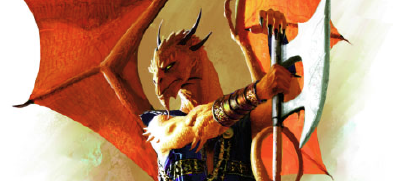
What do you mean I’m trying too hard? Naw bro, I always lean on my axe to do wing-stretches.
Winged scaly bipedal servants of the dragons, they are new to AE as they were brought with the dragons upon their return. The dragons clearly did not intend for the dracha to be doing much of the thinking; their bonuses are mostly geared towards the physical and they're straightforward almost to a fault. They start off being able to glide with their wings, as they take racial levels they become capable of true flight, and with evolved levels they gain a breath weapon and improved flight. If you want to be a dragon man who flies around setting fire to thatched-roof cottages, Dracha is definitely the way to go.
Faen
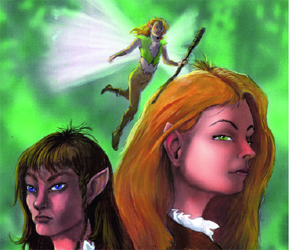
Ha ha! Not to scale.
Faen actually refers to three fairly distinct subraces. Each would be distinctive enough to refer to as a separate species, but they interbreed freely and live together, so I suppose it works for them. The one element that connects all faen is that they're small and clearly drawn from legends of the fey, given the so-subtle hint in their name There is an immediate comparison to be drawn with the other small races of D&D tradition, but faen aren't annoying fucks like kender, fat layabouts like halflings, or wrinkly tinkerers like gnomes. Loresong faen are magical with innate spell-like abilities, and unsurprisingly serve as the scholars and historians of the species. Quickling faen are the more physical variety, being fast and agile. Both types of faen may choose to transform into a spryte at 3rd level or beyond, going from small to tiny and sacrificing their original racial bonuses in exchange for wings. And before I hear, "But how do they...", the book specifically mentions that sprytes are infertile, you sick fuck. Neither loresong nor quickling faen have racial levels, spryte racial levels grant improved flying ability and spell-like abilities. All three types of faen do have evolved levels, pushing them further into their specialties, loresongs and sprytes grow more magical while quicklings become crazy fast. On a side note about mechanics, tiny creatures in normal D&D have some crippling disadvantages such as not threatening outside of the space they're in and having to occupy the space of anything they're trying to attack, but sprytes are treated as larger creatures for the sake of convenience and occupy space and threaten spaces around them. Despite that, there's the ever-present danger of blonde men in green dresses sticking them in bottles to later devour, so opting to play a spryte is something of a risk.
Oh, and they make fucking airships. He calls them sky ships and they're of the blimpy kind rather than anything more science-fantasy, and propelled by magic instead of steampunk, but still, airships. Which is mentioned on exactly two pages in the entire book. You might think that the fact that air travel exists is sort of maybe an important detail to know about a world and deserves more than a throwaway mention. Monte Cook disagrees!
Giants
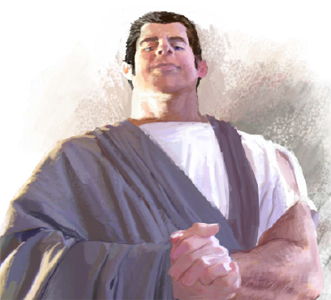
Try to get me to say ho ho ho one more time, motherfucker. I dare you.
Okay, you know how nobody takes Hobbits seriously because they're useless little bastards just scampering all over the place? Well welcome to being on the other side of that equation, because most everyone else is child-sized to the giants, who have a hard time taking them seriously when they're just so small and adorable. Most fantasy gamers when they think of giants think of big caveman-looking things with apeishly long arms and the intellect of a houseplant. These giants are not like that in the least. AE giants are proportioned like humans, not stupid, and live highly ordered lives centering around ceremony and ritual. Like I mentioned earlier, giants are planners and builders to put the Romans to shame. They are also the poster children for AE's focus on rituals in feats and magic and roleplaying; rituals are such a part of these peoples' culture that when they as a race decided to go to war against the dramojh, they didn't just flip out, they very carefully set up a ritual for flipping out super hard. If you take for example the Japanese love of various daily ceremonies and dial it up to 11, you get an idea about what the giants are like.
Giant characters start at medium size, albeit the upper end of medium at around eight feet tall. Taking the giant racial levels upgrades the character to large size, with all of the bonuses associated with it, and there is a prestige class that can boost it further to huge. There are evolved levels for giant, but as being mutated by dragons into a perversion of nature is not looked upon favorably by the giants, there aren't many valid reasons for a player to receive evolved levels.
Litorians
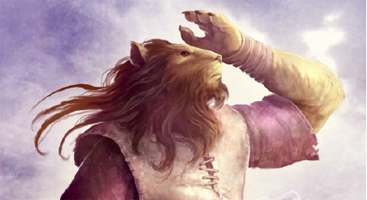
Mooom get out of my room, I told you I’m a lion inside!
We're going to have to stop here for a minute and have a little talk. The whole dragon-men thing with the Dracha probably made it under most peoples' radar, because lizardmen are sort of a fantasy staple, and because their backstory pretty much makes sense. Dragons built a dragon-ish servant race, sure. Well now we have lion-men too, and spoiler alert, it's not over with the lion-men; there are furries in AE. That being said, I have to give Monte Cook credit in the fact that none of the animalistic species were written so lazily as to just make litorians into purry yiffy cat people. Nor did he take the sci-fi cliche and make them a group of angry klingons with fur. No, he took the high road, and made them wookies. Litorians are a tribal race of nomads who, despite being conversant with cities and technology, mostly choose to live simpler lives of freedom in the wilderness where they regard the honorableness of their behavior with the utmost scrutiny and always repay lifedebts. He literally used the word 'lifedebt', I'm not making this up.
As long as you can overlook the impending Lucasarts lawsuit, litorians actually serve an interesting role in the game as cultural foils to the giants and other 'civilized' species. They don't bother with ritual, ceremony, or laws, and go through life solely on their personal compass. Anthropology majors would call them a shame-based society, where most of the other people in AE are guilt-based. If you don't know what that means, get an anthropology major drunk and you'll find out soon enough. But in any event, the litorians weren’t a bunch of uneducated savages sitting around in squalor until the
Mojh
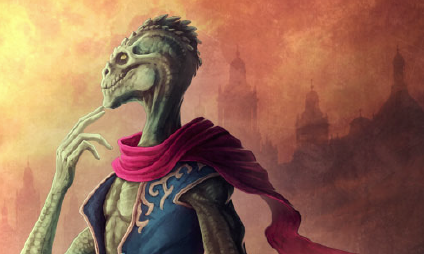
Smithers, release the hounds.
Mojh are… odd. For over a thousand years, humanity as a whole had its shit stomped by the dramojh. Generally speaking, this has given humans a fair distrust of draconic things. A minority of humans went the other way, believing that the dramojh held the key to power, and developed a ritual to sacrifice their humanity and even their gender to become an asexual being patterned after the dramojh. While frailer than normal humans and somewhat emotionally stunted, they gain in intellect and mystic power, along with a greatly extended lifespan. As you can imagine, this goes over about as well as dressing up as Hitler for a Bar Mitzvah as far as the rest of humanity and the giants are concerned, none of whom share the opinion that the dramojh ought to be emulated in any way. Most of the other species weren’t as badly fucked over by the dramojh as the humans and aren’t as likely to provide a free ass-kicking as a human would, but the mojh are far from popular and tend to live as hermits as a result. Only humans can be transformed into mojh.
Roleplaying-wise, mojh can be really cool or facepalmingly bad. It’s entirely too easy for someone to play a mojh as a chaotic-neutral murderhobo, slap on a moustache for them to twirl, and make long-winded screeds about how they lust only for power, etc, etc. However, the transformation into a scaly Mr. Burns costs them dearly in addition to making them a permanent exile. It’s a change far above going to college and being all, “Fuck you dad, I’m getting a tattoo!” It even makes the trials that transgendered people go through seem easier in comparison, because they don’t turn into freakish snake monster people, no matter what Pat Robertson would have one believe. The point being, the transformation into a mojh is a life-changing event, irreversible, and not something that anyone would do lightly. And the only people who can do it are people belonging to the species most victimized by the dramojh, and therefore most likely to be reviled by everyone they knew if they do make that choice. Exploring what would drive a person to such an extreme act is fertile ground for GMs and players alike, as long as they don’t fall for any lazy cliches along the way.
Just as a bit of rules geek side-note, in AU mojh received a breath weapon in their racial levels but did not gain spells in a spellcasting class. Their caster level increased with racial levels, but they fell behind in spell selection. With AE their breath weapon got hijacked by the more physical dracha, so in exchange mojh levels are now less disruptive to a spellcasting career.
Runechildren
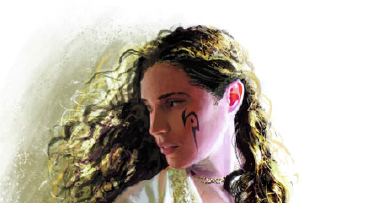
Yeah, so spring break was crazy. I woke up thinking I’d gotten a tattoo while blackout drunk, but turns out I have to defend the helpless.
Anyone of any species can become a runechild, a creature tapped by unknown forces to contribute for the good of the world, and as such the player doesn’t get to choose to be a runechild, it’s granted instead. A character level is sacrificed, and access to spell-like abilities is gained in its place, abilities that grow in number and power with total character levels. They are also marked with a rune on their hand or face to announce to the world that everyone should pester them to solve everyone else’s problems. Technically animals can be runechildren as well, there are rules for them in the monster book, but they’re only concerned with helping other animals and don’t give much of a fuck about the bipeds, so PCs are unlikely to ever encounter one. For a setting that generally ignores alignment, runechildren are a bit of an abnormality in that they’re clear-cut paladinish goody two-shoes. As such, I’ve never heard of them being prominent in any AE game, but the option exists for any GMs who want to make use of it.
Sibbecai
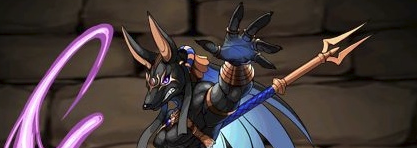
Less useful than Bastet.
The second of the furry species, the sibbecai are effectively the exact opposites of the litorians. Instead of lion people, they’re jackal people. Instead of preferring to be in the wild, they prefer cities. Instead of putting value on honor and self-worth, they put value on their reputation and social standing. They’re motivated heavily by ambition and achievement. This doesn’t make them any better or worse than other people; if anything a ‘career-minded’ adventurer who’s in the line of work with the goal of retiring early as a rich local celebrity is probably one of the less-insane PCs you’re liable to meet when compared to the various fanatics, crusaders, and murderhobos. The giants brought the sibbecai with them when they immigrated, so the sibbecai have something of a reputation of being servitors to the giants rather like the dracha and the dragons, and given their love of cities and the fact that the giants build lots of cities, the two species get along well.
The racial and evolved levels for sibbecai are generally physical upgrades for them, providing a bite attack and the scent ability on top of stat boosts.
Verrik
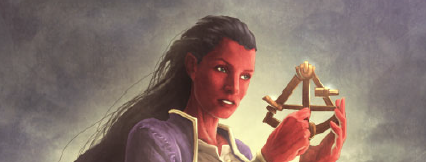
Verrik invented ocean navigation. They’re still working on sunscreen.
Verrik are arguably the weirdest species available to players, while physically being the most human. They’re human-sized, human-shaped, and apart from the burgundy-red skin outwardly indistinguishable from humans. But they’re possibly the least human species when it comes to how they think, and in roleplaying that’s the biggie. I’m just going to quote straight from the book here: “A verrik considers not only how a given course of action will affect her, but also how it will affect others (and thus, how that effect will affect her later). She looks ahead not just to tomorrow, but to next year, to 10 years beyond that, and to her children’s time as well. Thus, verrik often see others as short-sighted and frivolous.” They have a perspective that most humans simply cannot share, on top of psychic powers and a general lack of ostentation and strong emotion. Not vulcan-level emotionlessness, but an ability that humans don’t share to set aside their feelings when problem solving. It can be challenging for a player or GM to handle these outlooks.
Racial and evolved levels for verrik are focused heavily on boosting their psionic power. AE doesn’t have psionics in the sense of the alternate D&D rules with power points and crystals and junk; psionics in the book are treated identically as spells for the sake of rule mechanics, and verrik psionic powers are spell-like abilities with a number of uses per day.
Verrik also freak people out. Their way of thinking comes across as alien to the other species, and their innate charisma penalty is explained as a vague but persistent feeling of ‘wrongness’ that others have around them. In reality, they murdered their god when they felt they had no more need of him in ancient days, and are all cursed as a result. The ones with the charisma penalty are the ones who got off lightly, while the worse-off are horrible Lovecraftian abominations that other verrik keep locked away where nobody can discover them and learn their species’ collective terrible secret.

So that’s the races. Some of them are neat, several are strange, and a couple are a bit underwhelming, but they are at least not the usual suspects of Tolkien ripoffs you’ll see in most fantasy gaming. so I’ll give them that much.
Next: Classes!
Part 2
Original SA postHeren lies the second part of my Arcana Evolved writeup. Behold!

Akashic
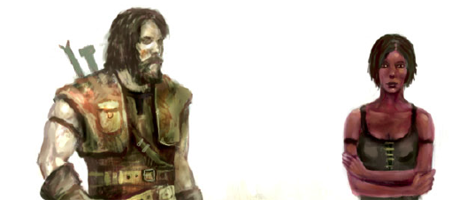
Tank, I need a pilot program for a B-212 helicopter.
For anybody who is not up on their occult cosmologies, the akashic record is is an actual thing in Earth’s philosophies, the indelible store of all knowledge that has ever existed within all living things. Those who are interested in that sort of thing can go and wikipedia it, but the gist is this: akashics in AE can access the entire sum of knowledge in the universe. If you want a class that is all about creative problem-solving and exploration, this one’s for you.
So what does that actually mean, rule mechanics wise? Well fortunately for all GMs everywhere, things in the akashic memory are only findable if several people know or knew about it, so something known only to a small group (e.g. the specific details of the dark lord’s plans) are not something that a player could get just by rolling a 20. Akashics have every skill as a class skill, bonuses on remembering anything they’ve encountered, and then a huge assortment of options on how to customize themselves as they go up in level. They can gain access to feats, information-gathering spell-like abilities on par with a diviner, combat bonuses, access to sneak attacks, bonuses to impersonate people, the ability to steal or alter the memories of others, and eventually the ability to temporarily use feats and even spells on the fly. This is very much a jack of all trades class; depending on where a player chooses to specialize an akashic can wind up very like a rogue, a psychic, or a fighter, or likely some blend of all three.
Champion
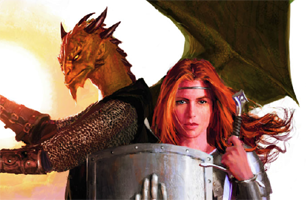
BY THE POWER OF GRAYSKULL!
Champion’s are AE’s paladins, and like the name implies, they get where they are by championing a cause. Unlike paladins, that cause needn’t be a good one. At the start, champions choose a fairly broad cause like life, death, knowledge, freedom, light, dark, justice, etc. When they get into the mid levels, they can choose to specialize and champion a species, a place, or a specific person, or remain in their general cause. The bonuses they receive for what they choose to champion vary fairly widely, but a common theme to all champions is that they get to He-Man out, summoning magical weapons and shields appropriate to their cause and eventually becoming able to just flat-out transform into an avatar of the cause with hefty bonuses. All champions are also proficient in heavy armor. Rules are provided for GMs who want to make a champion of a cause not already listed in the book.
Champions are pretty straightforward, generally speaking, in the same general area of complexity as a paladin without a spell list. They’re good for a player who wants a character that’s a badass for a specific reason, has some thematic powers for flavor and just wants to whip ass without juggling spell lists.
Greenbond
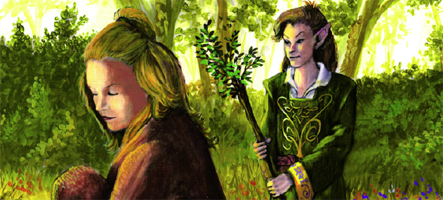
You can tell how much they love nature because they can sit around a bunch of useless grass all day.
Druids. Next.
Okay, not entirely druids. But like druids, greenbonds are spellcasting specialists who are focused on nature and life. Unlike druids and their animal fetish, greenbonds focus more on the spirits in the world, able to see and talk to them where others can’t, and become more plantlike than animalistic as they level. They can heal the living and damage the dead with their touch, and the fact that they along with the magisters are the only class that gets to level 10 spells means that they are not to be taken lightly. Additionally, greenbonds are fairly unique in AE in not requiring a staff or somesuch to work their magic; the only way to keep a greenbond from casting aside from things like anti-magic areas is to interrupt them with an old-fashioned pummeling or somehow prevent them from talking.
To get the most out of the class, a player has to have a pretty firm grasp on just how weirdly spiritual it is. If you’ve ever seen Princess Mononoke with all the freaky little forest spirits, a greenbond is basically seeing those everywhere,
all the time.
While becoming more and more a part of the natural planet until they eventually become a literal plant. Most classes in RPGs are setting-neutral, but greenbonds are up there with paladins in the sense that the class itself has a strong impact on how a character would be played. Not in the sense of a rigid set of rules like a paladin, but in the fact that the world they live in is very different from what everyone else sees.
Mage Blade
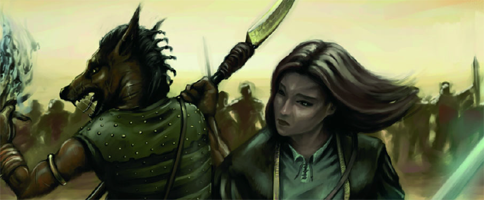
The only class that gets an illustration where they’re kicking ass.
Everyone who played AD&D as a kid at some point made a fighter-mage. Everyone. Yes, you too. Don’t lie. However, when you get down to it, fighter-mages are a poor mix. They sacrifice huge amounts of magey power in exchange for the ability to not be very good at hitting something for 1d8 damage. If you tried it in later editions you would be even more gimped by the impossibility of casting any spells with somatic or material components while your hands are full of sword.
Mage blades do a very good job of making the combo work. At their heart, they’re what all the old-edition fighter-mages wanted to be, a successful fusion of ass-beating and setting people on fire while looking cool. They enchant their weapon, which must be bladed though not necessarily a sword, so pretty much any non-bludgeoning melee weapon works. As long as they’re holding their weapon, they can cast spells through it with only their voice, circumventing spell failure for holding a sword and being in armor. Speaking of armor, a class feature that is long overdue is one exclusive to mage blades that negates the movement penalty of medium armor. Yes, someone finally came up with an actual reason to wear medium armor instead of just chain shirts or full plate!
That would still leave you with someone who sacrificed high-level spells in exchange for hitting something for 1d8 damage, which is not a great trade. So here’s some of the cool stuff the mage blades bring to the table! Their chosen weapon grows in power as they level, gaining up to +5 and is eventually capable of being teleported to them (but if it gets busted they suck at spellcasting until they perform a ceremony to imbue a new weapon with that power). They can cut through magical protection, raise a force field around themselves for a deflection bonus, and eventually
parry spells.
If the thought of swatting away an incoming lightning bolt with your sword doesn’t give you at least a slight nerd boner, you’re dead inside.
Magister
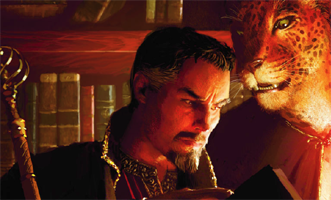
This picture of Doctor Strange proves that Marvel will sell out for a crossover with anybody.
Gandalf as fuck. Seriously, these guys get enormous cosmic power, and it all hinges on their staff, without which they’re gimped. It’s almost a copy and paste from Tolkien. They’re the most powerful spellcasters in the game, and they get to choose from selections of flavor powers like glowing eyes, becoming more intimidating at will, knowing whenever anyone speaks their name, using smarts instead of strength for skill checks to move or open stuff, and so on. If however their staff gets taken or destroyed, they cast at one level lower with doubled casting time, making the preferred tactics of dealing with them in a fight somewhat obvious. The staff gains hit points as the magister levels to keep it from ever being too trivial to sunder, and one of the options for their 18th level magical power is the option to not need their staff for casting, which some DMs will probably opt to house-rule out, as their reliance on their staff is a major balancing factor for the class.
Monte’s love letter to spellcasters, a.k.a. the spell system in AE, allows for a lot of variety for what would otherwise be a very vanilla class. No two magisters should be very much alike in their spell selections, as most of the best spells are walled off behind feats needed to unlock access to them. Those exotic spells are what will set the various casters apart from one another; most magisters should feel a lot like specialist wizards in AD&D where they’re great in their specialization and only middling at other stuff.
Oathsworn
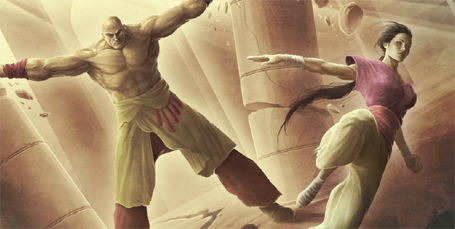
Oh, you liked this building? Well FUCK YOUR BUILDING.
As the name implies, oathsworn are people who have bound themselves with an oath. Either to do something, or prevent something, doesn’t matter. Only these people are so batshit crazy for their oath that it gives them the power to kick peoples’ heads clean off without weapons, because weapons are for pussies, resist blows without armor because armor is for pussies, perform amazing feats of strength and endurance, and live without needing trifles like food, water, or
air.
Because air is also for pussies.
Oathsworn have most of the abilities of monks, given that they flip out and kick peoples’ asses with unarmed attacks. However, everything they do is framed in the oath they have taken. This is potentially a huge problem for one’s game, and a lot of care has to be taken involving the oath. The oaths can’t be stupid or vague, so your old-school chaotic neutral munchkining like, “I swear to keep all of the party loot and kill any party member who objects.” is not gonna fly. It has to be something specific that the oathsworn is working to cause or prevent. If it’s an oath to make something happen, it must be fulfilled within a year of being made or the oathsworn is considered to have broken it and loses their powers for a month before they can swear a new oath. If the oath is to prevent something, as long as that something has not happened within a year they can just renew their oath for another year without any break. This can put something of a strain on a player, because swearing an oath like “I shall retrieve the crown of McGuffin!” puts them in a bad spot when the party retrieves the crown. They either have to retire the character or find a new cause to follow at that point. There’s also a roleplaying restriction on them in that they shun tools and equipment for anything they could accomplish without it. So no armor, no weapons, no mount, no nothing that the character wouldn’t consider essential. The book does at least make a point of saying that they aren’t retarded about it and will accept expedient measures to accomplish their goals. They’re just
so hard-core
that they live an insane spartan life and shun anything that seems like a luxury in the process.
As they level, oathsworn pick up immunities like other classes loot corpses. Fear, fatigue, poison, disease, sleep, blindness, deafness, dazing, stunning, paralysis, nausea, aging, energy drain… It becomes more and more difficult to stop an oathsworn from reaching their goal, whatever it may be. They also get combat rites for free as they level, which leads us to:
Ritual Warrior
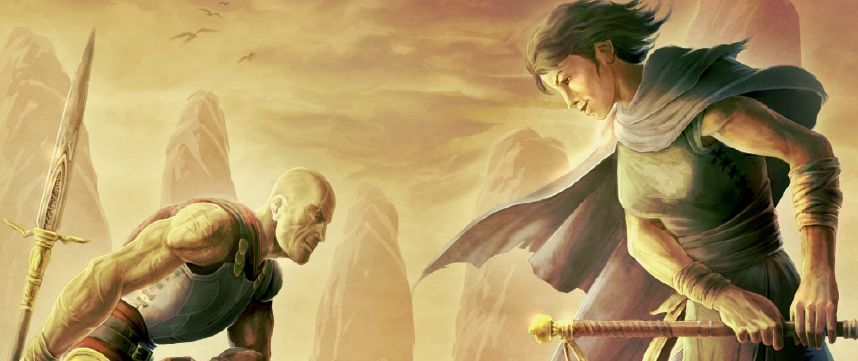
No illustration highlights a dynamic and tactical class like… standing in place slightly bowing.
A new class in AE, ritual warriors are sort of the fighty version of magisters: a mechanically-simple class that enjoys diversity through the abilities they bring to the table, in this case combat rites instead of spells. Without the combat rites, a ritual warrior is basically a 3E fighter with a worse attack bonus and better skill access. That would be boring as fuck however, so the upside is that they get the most combat rites of any of the martial classes and eventually become able to use unlimited combat rites, the only class able to do so. This gives access to dozens of at-will combat options and a few out of combat perks like boosts to sneak, tumble, jump, and balance. Anyone who’s ever tried to “make being a fighter actually work” in 3E by taking the feats for tactical stuff like tripping and disarming things will be very pleased at the options this class brings to the table.
Runethane
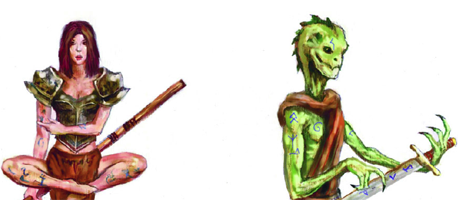
It was evidently “bring your kid to work day” when this illustration was made. Distressingly, little Billy’s signature was cut from this artwork.
Runethanes are basic spellcasters, in the same boat with mage blades and witches in having a reduced spell inventory relative to magisters and greenbonds. The advantage they receive in exchange is runes. Which are awesome if you love being a sneaky bastard who gets enjoyment out of being two steps ahead of everyone else.
The deal with runes is that every level the runethane learns a new rune from a list of available options, and which are then drawn on things by the runethane. Some runes are meant to be drawn on a creature or item to enhance it in some way, but many of them are meant to used as touch-triggered traps drawn anywhere between one square inch to a ten by ten foot area. Oh, and they can be invisible at the runethane’s discretion. Muahahaha. At the highest levels, runethanes gain access to ‘ultimate runes’, which instead of working off of a fixed list of powers can replicate the effects of any spell or rune up to a certain level. Basically, a runethane with a few seconds to themselves can have an area covered in nasty surprises for enemies, have a few bonuses for friends up their sleeves, and still have a repertoire of spells to cast normally, while having a pocket full of stones painted with one-shot touch-activated runes.
Of interest to runethanes, there is a weapon enchantment called Runic, which makes the weapon able to hold a rune on it without counting against the runethane’s limit of active runes. There are a variety of runes that do bad things on touch like creating a blast of elemental damage, putting the target to sleep, summoning an angry elemental to attack the target, etc. And there is a feat called Hands as Weapons which lets you have your hands enchanted as if they were a magic weapon. Think about it. You’ll thank me when you’re punching peoples’ faces with fireballs.

Totem Warrior
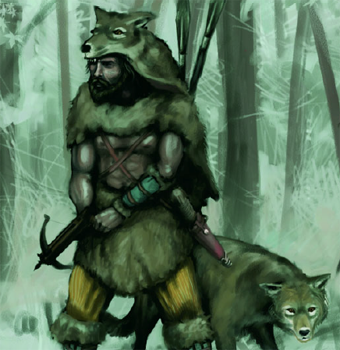
Okay look, someone needs to tell George that wearing Ollie’s corpse is just freaking out the rest of the pack.
You know companion animals? Those things that suck and die and generally serve only to penalize your character because their beloved horse/dog/mongoose/etc. died and inflicted like a month’s worth of morale penalty on their master? Well fuck those things (not literally) because here comes the totem warrior, the first class in the history of ever that made an animal-themed class not suck horribly!
So it’s simple enough. They pick an animal. The book includes bear, hawk, shark (yeah, useful in the forest), snake, wolf, and wolverine, as well as guidelines for making totem warriors of other animals. They then get the animal. Now this is where the magic happens, and I hope you’re sitting down: The animal gets a level every time the character gets a level, gaining hit dice, stat bonuses and eventually growing in size. MIND BLOWN. That way instead of your valiant wolf companion from 1st level with 8 hp being a shitty wolf companion at 17th level with 20 hp, a totem warrior’s wolf at 17th level will have an average of 128 hp, have grown to the size of a dire wolf, and be ready to rip faces clean off of people. The totem animal is a permanently useful feature for the class and not something that will be outgrown or a burden.
On top of that, the totem warrior receives very unique buffs and different skill proficiencies depending on their totem. For example, bear warriors get d12 hit dice, boosts to natural armor, strength, and reach. Whereas a hawk warrior gets d8 hit dice, dodge bonuses, boosts to archery skills, and the ability to fly. All totem warriors gain the ability to shapeshift into their totem form, with the same leveled-up boosts of their companion animal, communicate with animals of a similar nature to their totem, and eventually communicate with the spirit of their totem for information.
Unfettered
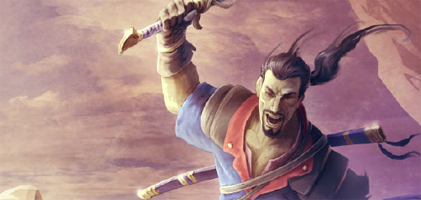
Not pictured: A magical floating balcony with a rope to swing from.
Unfettered are the sort of people who are only having fun while leaping off of a balcony to swing on a chandelier and kick some asshole in the face while laughing the entire time. They’re a pure melee class, sort of a cross between a fighter and a rogue. They get an AC bonus as long as they’re in light armor, a bonus to parrying in addition to any parry bonus on the weapons they’re holding, evasion, and sneak attack damage. Unlike rogues, they aren’t restricted to light weapons for sneak attacking; go crazy sneak attacking with a greatsword if you feel like it. As they progress, the dodge and parry bonuses increase and they become capable of parrying ranged attacks and even spells if their weapon is magical (though unlike mage blades they can’t completely deflect the spell, they instead receive a +4 bonus on their save against it).
The spirit of the class is essentially being a rogue who is a front-line fighter rather than running up and backstabbing people; while they receive access to rogueish skills the dodge and parry bonuses to their defenses allow them to go toe to toe with bad things without feeling squishy about it. My only complaint is the lack of inherent combat rites in the class. They don’t have any supernatural tricks up their sleeves to liven things up, and can be prone to being dull in combat as a result. Thematically it makes sense as combat rites hinge on wisdom and swashbucklers aren’t a very wisdom-prone group, but I would opt to use feats to gain combat rites on an unfettered to allow for more flexibility in a fight if I played one.
Warmain
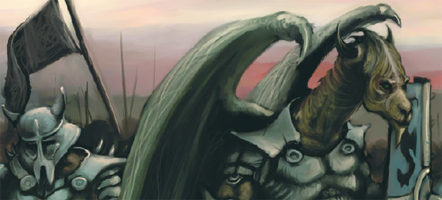
The first class in d20 to have a triple-digit AC.
The other side of the pure melee coin, warmains are tanks. They wear giant armor, swing giant weapons, have tons of hitpoints, and hit things really, really hard. And when I say giant weapons, I mean it: the class has a feature to let them wield weapons one size category larger than themselves one-handed, or two size categories larger than themselves two-handed. If rolling out onto the battlefield in inch-thick plate with d12 hit dice while dual-wielding greatswords is your thing, this is your class. They gain access to combat rites, though relatively meager compared to oathsworn and ritual warriors, the ability to automatically crit a finite number of times a day, and a pile of feats for further access to combat tricks.
Both unfettered and warmain are lacking in flashy tricks for my taste, but any player who wants to be a martial badass couldn’t do better than picking from these two. They both make D&D melee classes look like chumps in comparison, being powerfully focused on their respective specialties.
Witch
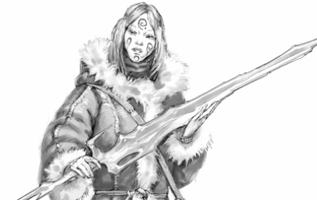
Weighs more than a duck.
The last class and another very flavorful one, witches are very like champions and totem warriors in that the class is more like a collection of distinctive subclasses each with very different flavors. Witches are focused casters with a fairly narrow specialty, broken down into iron witches, mind witches, sea witches, wind witches, winter witches, and wood witches. Each type of witch has their own bonus class skills, access to spell-like abilities themed to their ‘element’, additional thematic perks like resistances or saving throw bonuses against that element, and at 9th level gain access to
any
spell of that element of a level they can cast. That’s significant in that witches therefore get free access to exotic spells of their specialty without having to spend feats for them.
The downside of witches is their reliance on having a ‘witchbag’, or their pouch of random crap that serves as a material component for their spells. If they lose the bag, their spellcasting suffers in much the same way as a magister without a staff. The exception is mind witches, who can cast spells with the psionic descriptor without need of any components. Interestingly on the fluff side, it’s mentioned that mind witches insist that they’re psions rather than spellcasters. They don’t receive any distinction from other casters as far as mechanics go, but between their witchery powers and access to exotic psionic spells, they actually do give telepath psions a run for their money in the Professor X department.